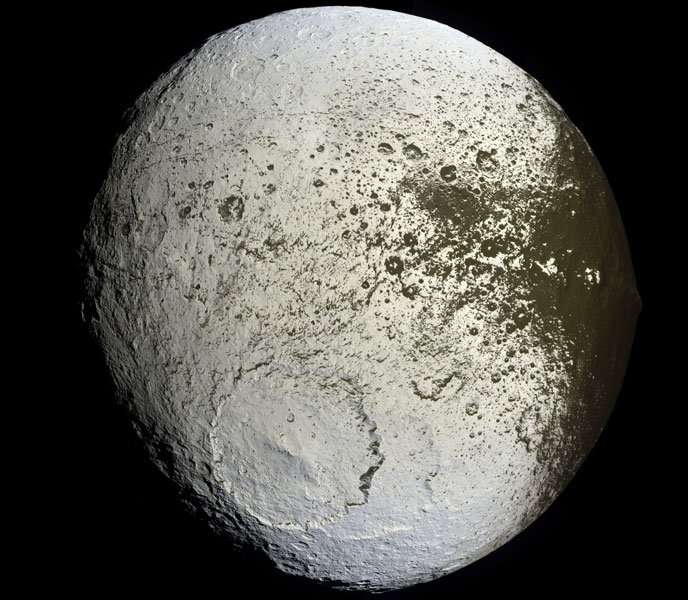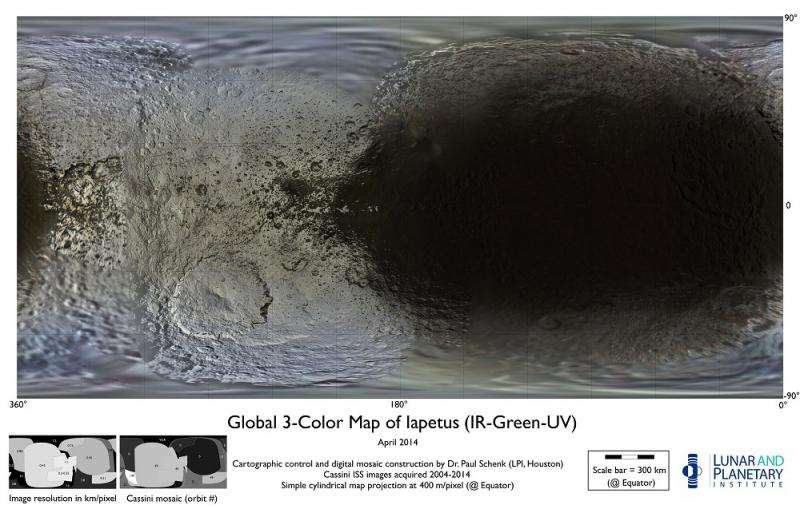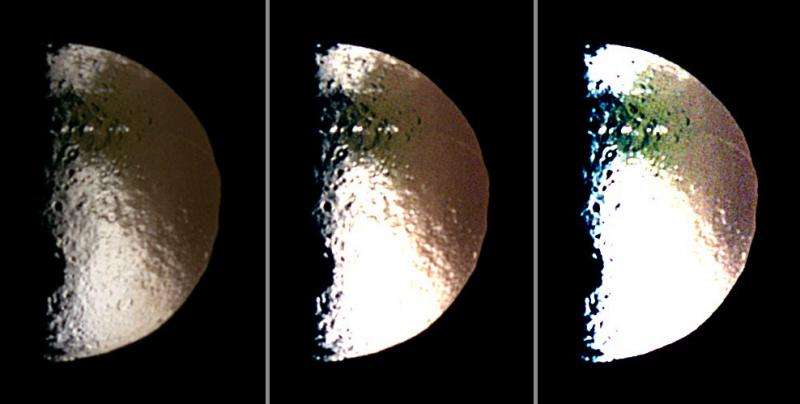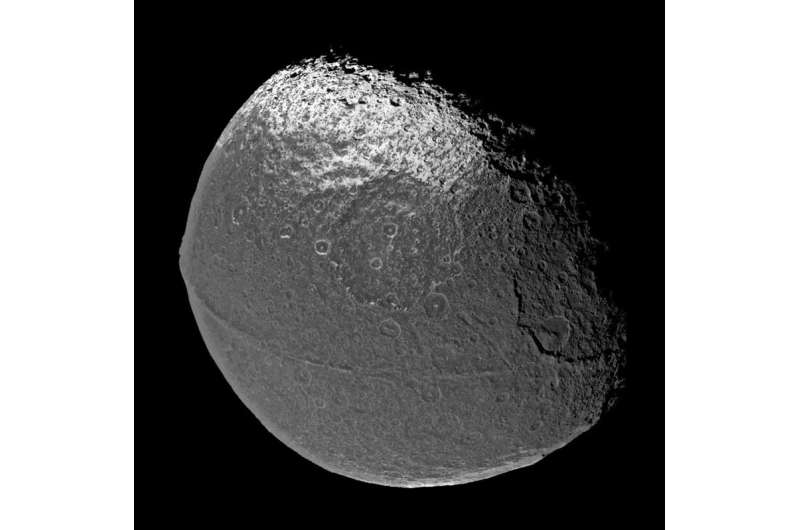Saturn's "Yin-Yang" moon Iapetus

Thanks to the Cassini mission, a great many things have been learned about the Saturn system in recent years. In addition to information on Saturn's atmosphere, rotation and its beautiful and extensive ring system, many revelations have been made about Saturn's system of moons. For example, very little was known about the obscure moon of Iapetus – sometimes nicknamed Saturn's "yin-yang" moon – before Cassini's arrival.
In addition to its mysterious, equatorial ridge, this moon also has a two-tone appearance that has historically made direct observation quite difficult. Due to its distance from Saturn, close-up observation with space probes has also been quite difficult too until very recently. However, what we have learned in the past few years about Iapetus has taught us that it is a world of stark contrasts, and not just in terms of its appearance.
Discovery and Naming:
Iapetus was discovered by Giovanni Domenico Cassini in April 1671. Along with Rhea, Tethys and Dione, Iapetus was one of four moons Cassini discovered between 1671 and 1672 – which together he named Sidera Lodoicea ("Stars of Louis", after his patron, Louis XIV). After the discovery, astronomers fell into the habit of referring to them using Roman numerals, with Iapetus being Saturn V.
The name Iapetus was suggested by John Herschel, the son of William Herschel, in his 1847 treatise Results of Astronomical Observations made at the Cape of Good Hope. Like all of Saturn's moons, the name Iapetus was taken from the Titans of Greek mythology – the sons and daughters of Cronus (the Greek equivalent of the Roman Saturn). Iapetus was the son of Uranus and Gaia and the father of Atlas, Prometheus, Epimetheus and Menoetius.
Geological features on Iapetus are named after characters and places from the French epic poem The Song of Roland. Examples of names used include the craters Charlemagne and Baligant, and the northern and southern bright regions, Roncevaux Terra and Sargassio Terra. The one exception is Cassini Regio the dark region of Iapetus, named after the region's discoverer, Giovanni Cassini.
Size, Mass and Orbit:
With a mean radius of 734.5 ± 2.8 km and a mass of about 1.806 × 1021 kg, Iapetus is 0.1155 times the size of Earth and 0.00030 times as massive. It orbits its parent planet at an average distance (semi major axis) of 3,560,820 km. With a noticeable eccentricity of 0.0286125, its orbit ranges in distance from 3,458,936 km at periapsis and 3,662,704 km at apoapsis.
With an average orbital speed of 3.26 km/s, Iapetus takes 79.32 days to complete an single orbit of Saturn. Despite being Saturn's third-largest moon, Iapetus orbits much farther from Saturn than its next closest major satellite (Titan). It has also the most inclined orbital plane of any of the regular satellites – 17.28° to the ecliptic, 15.47° to Saturn's equator, and 8.13° to the Laplace plane. Only the irregular outer satellites like Phoebe have more inclined orbits.
Composition and Surface Features:
Like many of Saturn's moons – particularly Tethys, Mimas and Rhea – Iapetus has a low density (1.088 ± 0.013 g/cm3) which indicates that it is composed primary of water ice and only about 20% rock. But unlike most of Saturn's larger moons, its overall shape is neither spherical or ellipsoid, instead consisting of flattened poles and a bulging waistline. Its large and unusually high equatorial ridge (see below) also contributes to its disproportionate shape.

Despite this, Iapetus is the smallest known moon to have achieved hydrostatic equilibrium. Though its distinctive "walnut-shape" is not precisely spherical, it is still roughly an oblate spheroid, indicating that it has enough mass to have become rounded under the force of its gravity.
As is common with Cronian moons, Iapetus' surface shows considerable signs of cratering. Recent images taken by the Cassini spacecraft have revealed multiple large impact basins, with at least five measuring over 350 km in diameter. The largest, Turgis, has a diameter of 580 km, with an extremely steep rim and a scarp about 15 km in height. It has also been concluded that Iapetus' surface supports long-runout landslides (aka. sturzstroms), which could be due to ice sliding.
As already noted, another interesting feature on Iapetus is its famous equatorial ridge, which measures 1300 km in length, 20 km wide, 13 km high, and runs along the center of the Cassini Regio dark region. Though indications had been made as to the existence of a mountain chain in this region earlier, the ridge was observed directly for the first time when the Cassini spacecraft took its first images of Iapetus on December 31st, 2004.
But perhaps Iapetus' best known feature is its two-tone coloration. This was first observed by Giovanni Cassini in the 17th century, who noted that he could only view Iapetus when it was on the west side of Saturn and never on the east. At the time, he correctly concluded that Iapetus was tidally-locked with Saturn, and that one side was darker than the other. This conclusion was later backed up by observations using ground-based telescopes.
The dark region is named Cassini Regio, and the bright region is divided into Roncevaux Terra – which lies north of the equator – and Saragossa Terra, which is south of it. Today, it is understood that dark regions are carbonaceous, and likely contain organic compounds similar to the substances found in primitive meteorites or on the surfaces of comets – i.e. frozen cyano-compounds like hydrogen cyanide polymers.
The pattern of coloration is analogous to a spherical yin-yang symbol, hence the nickname "Saturn's yin-yang moon." The difference in coloration between the two Iapetian hemispheres is quite extreme. While the leading hemisphere is dark, with an albedo of 0.03–0.05 (and has a slight reddish-brown coloring), most of the trailing hemisphere and poles are almost as bright as Europa (albedo 0.5–0.6).
Thus, the apparent magnitude of the trailing hemisphere is around 10.2, whereas that of the leading hemisphere is around 11.9. Theories as to its cause generally agree that the original dark material must have come from outside Iapetus, but that subsequent darkening is caused by the sublimation of ice from the warmer areas of Iapetus's surface, causing volatile compounds to sublimate out and retreat to colder regions.
Because of its slow rotation of 79 days, Iapetus experiences enough of a temperature difference to facilitate this. Near the equator, heat absorption by the dark material results in a daytime temperatures in Cassini Regio of 129 K (-144.15 °C/-227.5 °F) compared to 113 K (-160.15 °C/-256.3 °F) in the bright regions. The difference in temperature means that ice sublimates from Cassini Regio, then deposits in the colder bright areas and especially at the even colder poles.
Over geologic time scales, this would further darken Cassini Regio and brighten the rest of Iapetus, creating a runaway thermal feedback process of ever greater contrast in albedo, ending with all exposed ice being lost from Cassini Regio. This model is the generally accepted one because it explains the distribution of light and dark areas, the absence of shades of grey, and the thinness of the dark material covering Cassini Regio.
However, it is acknowledged that a separate process would be required to get this process thermal feedback started. It is therefore theorized that initially, dark material came from elsewhere, most likely some of Saturn's small, retrograde moons. Material from these moons could have been blasted off either by micrometeoroids or a large impact.
This material would then have been darkened from exposure to sunlight, then swept up by the leading hemisphere of Iapetus. Once this process created a modest contrast in albedo (and hence, temperature) on Iapetus' surface, the thermal feedback process would have come into play and exaggerated it further.
The greatest source of this material is believed to be Phoebe, the largest of Saturn's outer moons. The discovery of a tenuous disk of material in the plane of (and just inside of) Phoebe's orbit, which was announced on October 6th, 2009, supports this theory.
Exploration:
The first robotic spacecraft to explore Iapetus were the Voyager 1 and Voyager 2 probes, which passed through the Saturn system on their way to the outer Solar System in 1980 and 1981. Data from these missions provided scientists with the first indications of Iapetus' mountains, which were thereafter informally referred to as the "Voyager Mountains."

Only the Cassini orbiter has ever explored Saturn's moon of Iapetus, which captured multiple images of the moon from moderate distances since 2004. For instance, on New Year's Eve 2004, Cassini passed Iapetus at a distance of 122,647 kilometers (76,209 miles) and captured the four visible light images that were put together to form the view of its equatorial ridge jutting out to the side (shown above).
However, its great distance from Saturn makes close observation difficult. As a result, Cassini made only one targeted close flyby, which took place on September 10th, 2007 at a minimum range of 1227 km. It was during this flyby that data was obtained which indicated that thermal segregation is likely the primary force responsible for Iapetus' dark hemisphere. No future missions are planned at this time.

Iapetus is a world of contrasts, and not just in terms of its color. In addition, it is a very small moon that still managed to be massive enough to achieve hydrostatic equilibrium. And despite being one of Saturn's larger moons, it orbits at a distance usually reserved for smaller, irregular moons.
Coupled with the fact that scientists are still not sure why it has its unusual walnut-shape, Iapetus is likely to be a target for any research missions headed to study the Cronian moons in the coming years.

Source: Universe Today





















